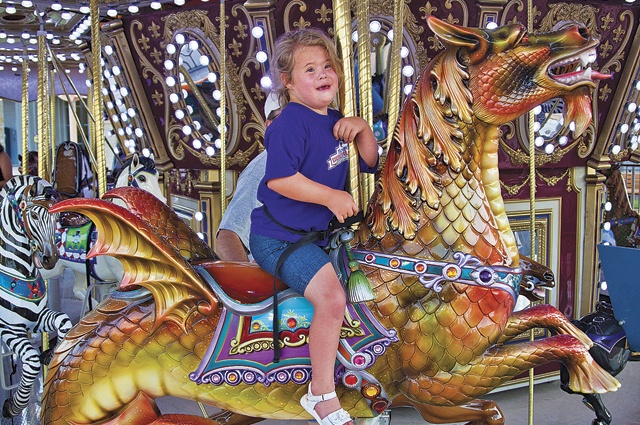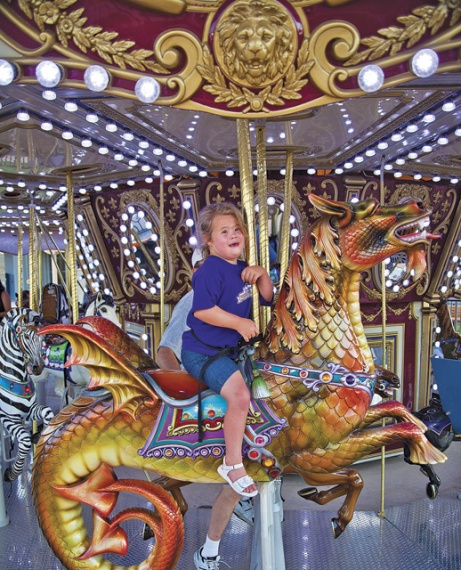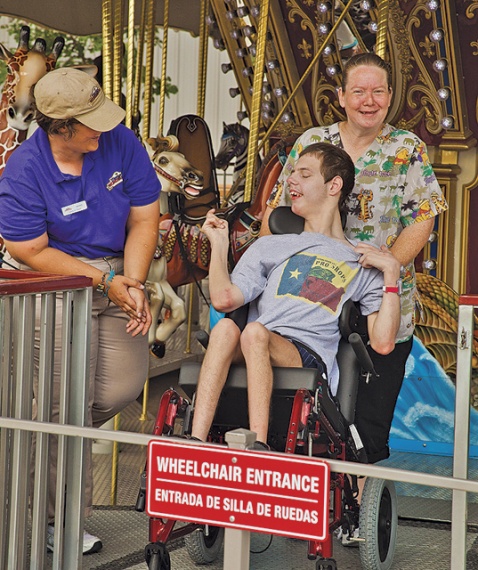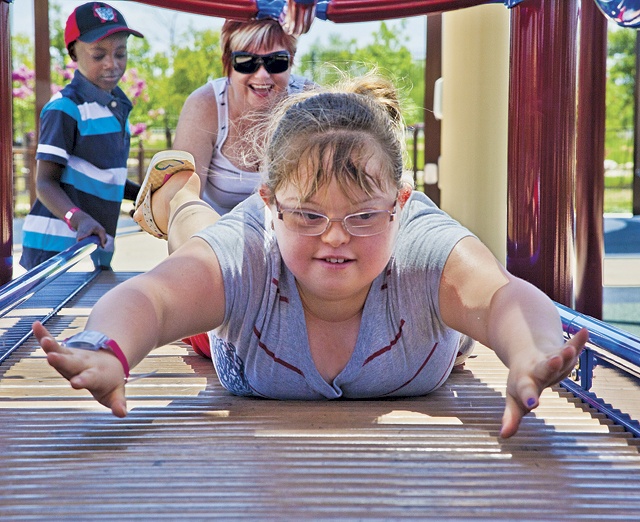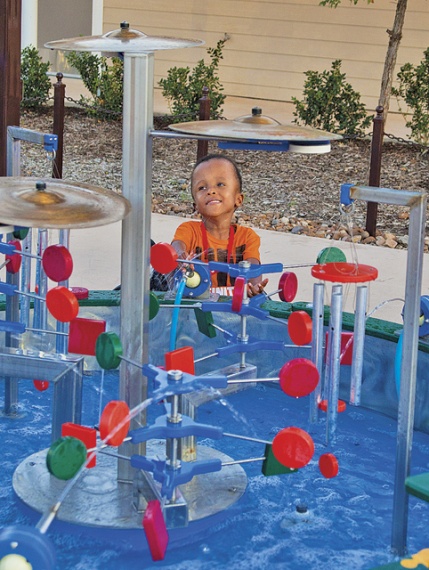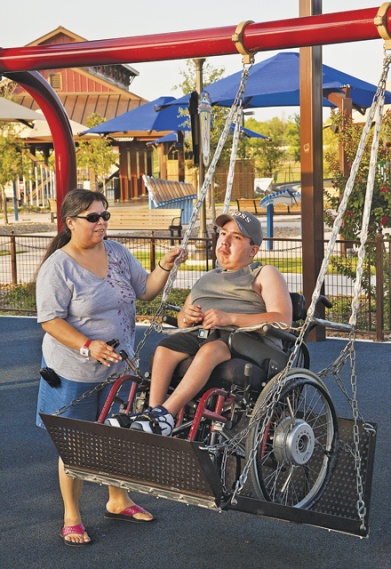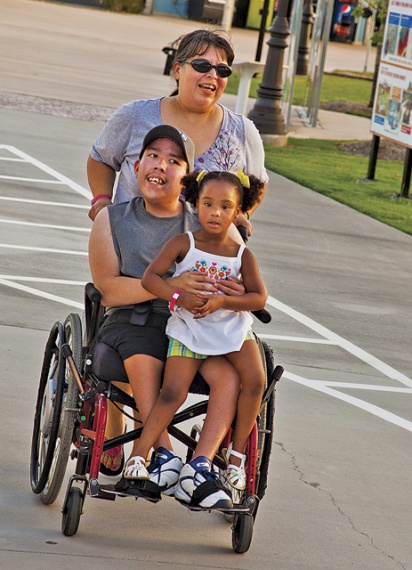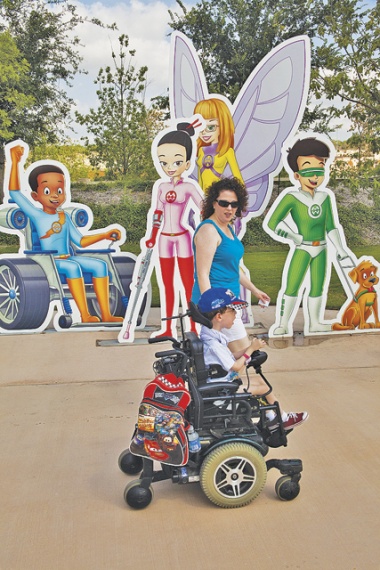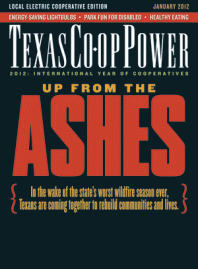Side by side, Sophia O’Neal and her little brother, Josiah, splashed their hands in the elevated pool at Water Works, an interactive play area at Morgan’s Wonderland in San Antonio. Intrigued, Sophia, 8, reached for a plastic tube and attached it to a gurgling contraption of pipes. From beneath his blue gimme cap, Josiah watched. But not for long.
“I’m ready to go!” the 6-year-old announced loudly. “I’m going to the playground!” Then he spun around in his motorized wheelchair and took off.
At that point, most mothers would have panicked. Instead, Amy O’Neal calmly smiled.
“Morgan’s Wonderland is such a great place,” she said. “Everything is completely accessible to Josiah. He feels like this park was made just for him.”
“My other kids have fun here, too,” added Amy, who traveled from Mississippi to visit family, “and I know they’re all safe.”
Billed as the world’s first ultra-accessible family fun park, Morgan’s Wonderland is a 25-acre amusement park that’s designed to be fun for everyone, yet specially built to accommodate children and adults with special cognitive and physical needs. Guests can ride in open-air railcars pulled by a miniature train; cruise in an off-road vehicle around a twisting track; pilot a remote-controlled pirate ship in a mini lagoon; and explore wavy slides, rocking seesaws and chiming music makers at colorful, shaded playscapes with cushy, rubberized surfaces.
Inside the Sensory Village, they can stand in front of a camera, point to temperatures on a map, and see themselves ham it up as a weather forecaster on television. In the Village Market, they can shop for carrots, apples, canned green beans and other make-believe (plastic) groceries.
Since opening in April 2010, more than 200,000 people from all 50 states and 30-plus countries have passed through the park’s gates. Many make special trips to the Alamo City so someone they love can experience something as simple as riding a carousel, likely for the first time.
“Last year, a family from Florida purchased an oversized van just so they could drive here,” former General Manager Dave Force said. “The parents told us that at last they had a place where they could take their two sons, who both have wheelchairs and oxygen tanks.”
Monumental Moment
In 2006, while on a family vacation, then 12-year-old Morgan Hartman longed to throw a ball with other kids in a hotel swimming pool. Morgan, who has a moderate cognitive delay, couldn’t ask to join in. As she inched closer, the other children, uncomfortable and unsure of what to do, climbed out of the pool. Nearby, her father, Gordon, watched as the scene played out to its usual ending. But this time, the sadness in his daughter’s eyes moved him more deeply than it ever had before.
That “monumental” experience, as he calls it now, also motivated him.
“Morgan was simply trying to integrate into their play,” he recalled. “I suddenly thought, ‘There’s got to be a place where we can all play and feel comfortable.’ Because of her limitations, Morgan can’t go to theme parks that are crowded, rushed and loud. So I decided I’d search for a place that might be close to what she needed.”
After several investigative trips, Hartman—a former homebuilder turned philanthropist—found nothing like he’d envisioned. “In January 2007, I returned home to San Antonio, determined that we would build a place that was ultra accessible,” Hartman said. He and his wife, Maggie, had already co-founded the Gordon Hartman Family Foundation, which helps Bexar County-area nonprofit agencies assist children and adults with special cognitive and physical needs.
“I thought that if we could do that,” Gordon Hartman said of building a theme park, “then we’d help bring down those barriers I saw that day in the pool.”
When Hartman hosted a public meeting in San Antonio to gauge interest in his idea, he assumed he’d only need a few chairs. “I was stunned when hundreds of people showed up!” he said. “I learned so much from the grassroots input we received. They told us that they wanted a safe environment where their special-needs children could feel comfortable and not rushed to enjoy the attractions. Within a year, we also raised $15 million in private and public donations just from the general idea of a special-needs theme park.”
Moving forward, Hartman and his team solicited more suggestions from therapists, teachers, doctors, caregivers and parents. For one year, architects, engineers and graphic artists—with no prior experience in designing amusement parks—fine-tuned a site plan and more than 20 attractions.
“I wanted people who were passionate and could think outside the box,” Hartman explained. Another year went into building the $34 million park, located in an abandoned quarry in northeast San Antonio. On April 10, 2010, more than 7,000 people joined Hartman in celebrating the grand opening of his daughter’s namesake—Morgan’s Wonderland.
Smiles Everywhere
At age 17, Jonathon Belz of Sulphur Springs had never ridden a carousel. But that was about to change. “He’s going to have a lot of firsts today!” exclaimed his mother, Candi Belz, who watched while a host securely strapped Jonathon’s wheelchair into a dragon-crested chariot. Then Candi and daughter Shellbie, 14, straddled galloping steeds behind him. Lilting pipe-organ music tinkled as the carousel, adorned with white lights and gilded mirrors, slowly began to twirl. In unison, the trio bobbed up and down on their seats.
“Sure beats the school bus any day, right, Bubba?” Candi sang out to her son. “What do you think? Is it fun?” In response, Jonathon flashed a toothy grin and waved his arms.
Uniquely designed for Morgan’s Wonderland, the old-fashioned-style carousel sits flush with the ground so guests don’t have to step up. In addition to several wheelchair chariots, a colorful menagerie of zoo-animal seats and benches accommodate riders who can’t sit upright or who require a caregiver next to them.
Meanwhile, across the park, Josiah was eating a snack at the shaded Sand Circle, where other kids dug in the sand with plastic shovels, toy trucks and accessible excavators. “I’m going to go swing!” he suddenly announced. With his mom in tow, Josiah headed for the swing sets.
From an array of traditional and adaptive swings, the little boy made a beeline for one specially made for a wheelchair. With Amy’s help, two park hosts carefully eased his chair up a short ramp. Then the hosts secured it on a steel platform suspended by heavy chains. Back and forth, they rocked the swing while Josiah relaxed. Now and then, his eyelids closed briefly.
“The swings are one of his favorite things here,” Amy said. “He almost fell asleep in one when we visited in March. I get so much joy bringing him here because he can feel normal. It’s very distressing as a parent when you go to a place and have to say, ‘No, baby, you can’t do that.’ But Josiah always handles it well. He’s a happy kid who dreams of walking someday.”
Fun for All
Force, the park’s former general manager who now is serving as a consultant for pending marine-life parks overseas, recalled how skeptics doubted whether an accessible park could be designed, much less built. “When we said we wanted a carousel with no ride restrictions, everyone said we couldn’t,” he said. “Where they saw barriers, we saw challenges. Now everyone who rides our carousel has the same up-and-down experience. That’s the whole idea behind Morgan’s Wonderland.”
“We’re trying to teach inclusive behavior here,” he continued. “Of our paid and volunteer staff, approximately 20 percent have special needs. We want everyone to play—and work—together and overcome barriers. Our highest compliment is when someone says that Morgan’s Wonderland doesn’t look like a special-needs park.”
That it’s a special place can be confirmed by the countless touching stories shared by visitors.
“One woman in her 50s swung here for the first time,” Force said. “She was surprised to feel her stomach do a ‘little flippy thing’ when she went back and forth. For the first time, a grandfather in a wheelchair was able to push his grandchild down a slide. Another family told us this is the only place where they can go as a family in one vehicle.”
“All those little things don’t change the rotation of the Earth,” he added. “But they make a difference in those people’s lives. When you see that happening every day, that’s Morgan’s Wonderland!”
——————–
Sheryl Smith-Rodgers, frequent contributor
